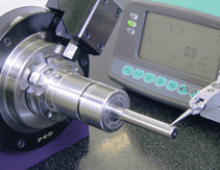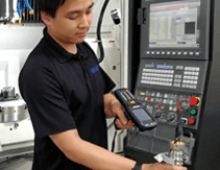Preguntas y respuestas: Automatización y conectividad con BIG DAISHOWA
Las soluciones automatizadas son cada vez más prominentes en la industria del mecanizado. El presidente y director de operaciones de BIG DAISHOWA, Jack Burley, el especialista sénior de producto Matt Tegelman y el ingeniero de investigación y desarrollo Nick Jew se reunieron para hablar sobre el estado actual del mercado, sus últimos avances y cómo podría verse en el futuro. Aquí hay algunos extractos de esa conversación.
P: ¿Puede contarnos sobre el recorrido de BIG DAISHOWA hacia las tecnologías digitales y conectadas?
Jack Burley: Hace veinte años, muchas herramientas manuales se estaban volviendo digitales, pero eran herramientas de medición muy simples. El concepto era: “¿Cómo ponemos ese tipo de tecnología en nuestras herramientas?” Nuestros primeros sistemas de mandrinado eran solo un cabezal con pantalla, pero esa función fue el primer paso de muchos que tendríamos que dar hacia el objetivo futuro de una manufactura completamente automatizada. Para lograrlo, la siguiente generación trabajó para que las herramientas pudieran conectarse a máquinas o controles.
P: ¿Cómo describiría el estado actual de la automatización en la industria? ¿Está viendo muchas operaciones adoptando la tecnología?
Matt Tegelman: Muchos talleres tienen pantallas de video en la entrada de una celda de mecanizado que muestran el tiempo de mecanizado y la productividad, pero mucho más se está registrando y comunicando entre máquinas.
En algunos casos, las máquinas de medición por coordenadas (CMM) automatizadas miden piezas y envían retroalimentación directamente al control de la máquina. Así, la máquina ajusta la trayectoria de la herramienta para mantener las piezas dentro de tolerancia, con poca o ninguna intervención humana.
JB: Si puedo añadir algo, sí, hemos logrado automatizar celdas de trabajo. Una pieza específica, o familias de piezas, pero aún no he visto el plan de proceso completo.
P: ¿Diría que solo estamos a mitad de camino?
JB: Supongamos que está fabricando una bomba industrial que tiene múltiples piezas producidas justo a tiempo; la automatización completa integraría todo: desbarbado, serialización, ensamblaje, empaquetado, y salida del producto terminado. Eso sucederá algún día, pero todavía falta mucho para lograr esa integración. No lo veo todavía; veo 50 piezas separadas en un contenedor al final del turno.
P: ¿Cuál es la filosofía de BIG DAISHOWA en torno a la automatización y cuáles son sus objetivos al desarrollar estas soluciones automatizadas?
Nick Jew: El objetivo principal es reducir la posibilidad de errores. Poder hacer un ajuste de manera segura y precisa. Tal vez incluso hacerlo sin intervención humana. Con los presetters también, tener todo conectado mediante redes permite transferir los valores de forma segura y correcta. Además, mejorar la usabilidad general, como leer una pantalla digital en un cabezal de mandrinado en lugar de marcas vernier en un dial de ajuste.
P: Recientemente presentaron el sistema de mandrinado totalmente automático EWA. ¿Reducir el error humano y aumentar la usabilidad fueron los principales impulsores de su desarrollo o hubo otros beneficios?
NJ: Hay un tema de seguridad. Permitir que las puertas de la máquina permanezcan cerradas y realizar los ajustes del cabezal de mandrinado automáticamente a través del software lo hace mucho más seguro.
Además, estos cabezales permiten ser más productivos. No es necesario esperar a que el operador haga los ajustes. De manera única, nuestro cabezal de mandrinado también puede mecanizar varios diámetros diferentes con el mismo cabezal. Puede completar piezas enteras sin necesitar cuatro o cinco configuraciones diferentes. Solo una herramienta. Esos son algunos de los objetivos que perseguimos.
MT: Ayuda en la planificación de la producción. Un taller puede estimar mejor el tiempo que tomará un nuevo trabajo. Y según el flujo de trabajo actual, pueden calcular con precisión los plazos de entrega, basándose en el flujo de máquinas y cómo planean procesar la nueva pieza. Pueden cotizar con mayor precisión.
P: ¿Hay mucho interés en soluciones automatizadas entre los clientes actuales?
JB: Hicimos una encuesta interna a nuestros clientes: “¿Actualizó de analógico a digital o es nuevo usuario de productos BIG DAISHOWA?” El 78% respondió que actualizó de analógico; el 22% eran nuevos usuarios. Así que muchos dijeron: “Usábamos analógico. Ahora usamos digital.”
P: ¿Eso significa que se están acercando a usar conectividad entre celdas, acercándose al plan de proceso completo?
JB: Cuando preguntamos: “¿Utiliza la función de conectividad Bluetooth, la capacidad de conectar la herramienta a un dispositivo externo como su iPhone?” Los resultados fueron 65% que no. Aunque tienen esta función, no la usan. El problema es que la conectividad generalmente se realiza mediante una aplicación en un dispositivo personal del empleado. Existe mucha reticencia a permitir el uso de teléfonos personales en un entorno de taller. Aún se considera algo opcional.
P: ¿Pero los clientes se muestran entusiasmados con las posibilidades que ofrece la conectividad?
NJ: Sin duda, eso despierta interés. “¿Podemos comunicarnos realmente con un cabezal de mandrinado desde un teléfono inteligente?” Estamos intentando adaptar el conjunto de habilidades para que sea más digital, porque esa es la tendencia cultural. ¿Por qué no aplicar esa misma tendencia en la fuerza laboral, convirtiéndola más en una habilidad tecnológica que en una habilidad puramente manual?
P: Finalmente, hablando de entusiasmo: ¿qué les entusiasma del futuro de la automatización y la conectividad en este negocio?
JB: ¿Cuándo comenzarán las máquinas a pensar por sí mismas, y podrán mejorarse sin necesidad de humanos detrás? Eso suena a ciencia ficción, pero creo que nos estamos acercando más y más.
NJ: Que un ingeniero de manufactura o un operador de máquina pueda no depender de la tecnología, sino tenerla como copiloto. Ser más eficiente, trabajar con más tranquilidad. Sin preocuparse de escribir un número incorrecto o cometer un error que dañe la pieza.
MT: Trabajar con estas herramientas da a los operadores un estándar más alto que alcanzar. Si no eres el operador más capacitado del taller, probablemente no tengas la oportunidad de programar y trabajar con este tipo de herramientas. Esto los motiva a mejorar sus habilidades y, al mismo tiempo, incentiva a los empleadores a reconocer esos logros y compensarlos adecuadamente. Les brinda oportunidades para ser más que simples operadores de máquinas y seguir creciendo desde ahí.
La automatización tiene un futuro brillante en la industria del mecanizado. Para obtener más información sobre ese futuro o consultar acerca del EWA, comuníquese con nuestro equipo de ventas hoy mismo.
¿Te pareció interesante o útil? Haznos saber tu opinión agregando tus comentarios o preguntas a continuación.



















Añadir nuevo comentario